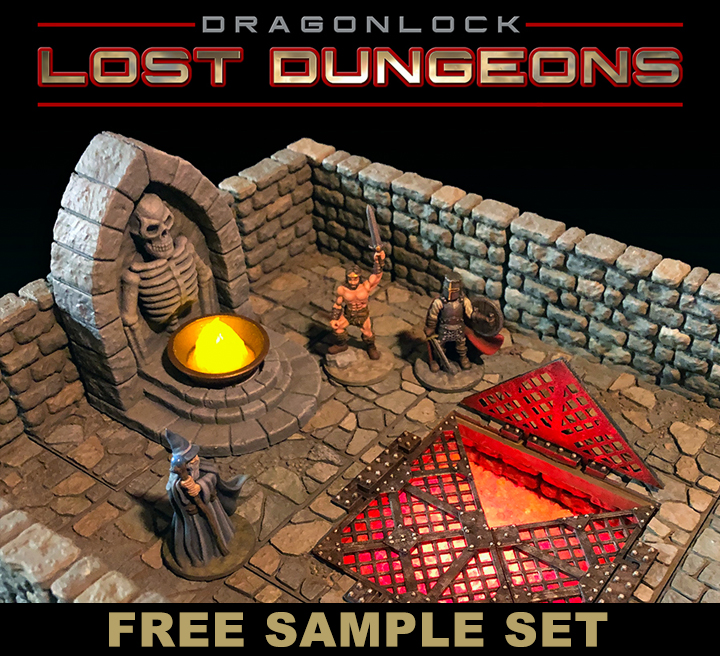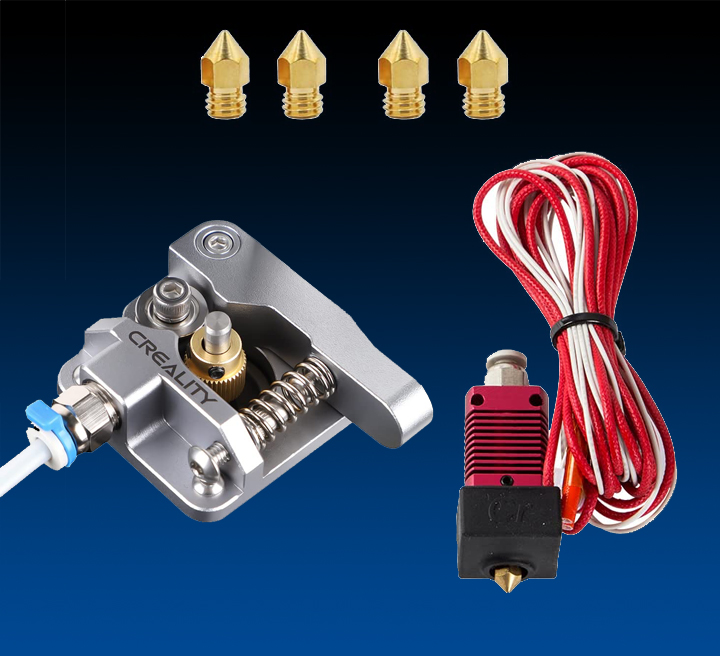Q: Where can I learn to use a 3D printer?
A: We have a Youtube channel devoted to this! Check us out HERE.
Q: How does a 3D printer work?
A: Home 3D printers fall into two categories, plastic filament and resin. We recommend starting with a plastic filament type printer (also referred to as FDM or Fused Deposition Modeling). This type of printer uses a spool of plastic filament to make models by feeding the filament into a heated nozzle, melting it, and extruding it on a build plate in successive layers to build up an object. The thinner the layer height you select for printing your model will result in much finer details and resolution, but thinner layers mean you must print more layers in total, thus resulting in a longer print time. The filament itself is very inexpensive (a 1kg roll for $20 will make 40-50 dungeon tiles).
Q: How hard is it to operate a printer?
A: As with most things, there is a learning curve to 3D printing. We recommend starting with a simple test object like this cube (http://www.fatdragongames.com/images/CUBETEST.stl) once you get your printer for the first day or two to get used to how it operates before attempting to print dungeon terrain or miniatures.
Q: Where can I get help and have questions answered?
A: There are several fantastic user communities like the Dragonlock/Dragonbite group on Facebook (https://www.facebook.com/groups/528423924186756/) and the FDG forums here on our website to get help and have questions answered.
Q: Are 3D printers difficult to maintain?
A: Not really (at least not the ones we have listed.) They aren’t totally plug-n-play, but the maintenance is really simple. Most maintenance takes the form of tightening bolts and lubricating the rods that the print head runs on, and periodic cleaning of the unit and making sure the belts are tight. If you can work a screwdriver you’ll be fine.
Q: How long does it take to print a model?
A: Time depends on the resolution you are printing at. As an example, on our Ender 3, we can print a standard 28mm skeleton miniature in about 1 hour, and a dungeon wall tile in 2.5 hours.
Q: What does the term ‘micron’ mean when listed for a printer’s resolution?
A: A micron is 1/1000 of a mm, so a printer than can print 100 micron layers is printing layers that are 1/10th of a millimeter high (.1mm). A machine printing at 200 micron resolution would have layers that are 2/10ths of a millimeter high (.2mm), thus the smaller the resolution number, the finer the print quality. A 50 micron print will look much better than a 200 micron print, but the 200 micron print will print much faster than the 50.
Q: What does it mean when a printer says it uses 1.75mm or 3mm filament?
A: This is referring to the diameter of the filament that will fit in the printer’s nozzle. 1.75mm is pretty much the industry standard and used by most printers. Be careful when buying filament to ensure you are getting the proper diameter for your machine.
Q: How much does it cost to print a model?
A: A 28mm humanoid miniature will run 7-12 cents, and a standard dungeon tile about 38-40 cents, depending on the price of the filament you use.
Q: What is the difference between PLA and ABS filament?
A: PLA is what we use for all of our printing, it is a bioplastic derived from corn starch or sugarcane, and is biodegradable. It is harder and slightly more brittle than ABS, and can be printed at lower temperatures, so it holds fine details much better. ABS requires a printer with a heated print bed, and it gives off very bad fumes when heated for the print process due to some toxic chemicals used in it. We really cannot recommend using it at all, especially in a home environment.
Q: Does a printer take a lot of electricity to use?
A: Not really, studies we have found online put it at less than having a 60watt incandescent light bulb turned on.
Q: What brand of filament should I use?
A: We recommend eSun PLA Pro, or Hatchbox PLA, as both are very easy to work with and produce excellent results. Cheaper filaments can induce clogs and be more difficult to use.
Q: Which printer should I buy?
A: There are many great printers out there. Our two favorites are the following:
Creality Ender 3 ($230): This printer has become our favorite in the office. It produces prints better than any other machine we have tried (even ones costing 4x as much!) The printer is a bare-bones machine, which means it does not have a lot of bells and whistles like auto-bed leveling, filament detection sensors, etc. None of these are essential, and the machine you get is a workhorse. Bed leveling is accomplished by manually turning four dials (one in each corner) of the bed, and will take you 15-20 minutes to do before the first time you use it. Once dialed in, you shouldn’t have to adjust it again for a long time. The only downside to this printer is it require partial assembly before use. Nothing too hard, just some screws and plugging a few wires in (no soldering required.) This is our top pick for getting started 3D printing at home, and we have a lot of linked resources at the bottom of this page for it.
Prusa i3 Mk3 ($999): This is the gold standard of 3D printers, with virtually every feature you could want like auto bed leveling, auto filament detection, magnetic removable bed, etc. It is good to go out of the box once you get the nozzle z-height calibrated. Prusa also has live 24/7 chat support via their website.
Ender 3 links:
Since the Ender 3 is so popular right now, here are selected links to purchase the printer, certain upgrades for it (Amazon links are FDG affiliate links), Thingiverse printable upgrades, and most importantly, the much better assembly instructions from manufacturer’s website (not included with the printer.)
Ender 3:
Bowden Tube fittings (not essential to begin with, but these are much better than the ones supplied with the printer and you will want to replace them eventually):
Extra nozzles:
https://amzn.to/2zqqH9Z
Micro SD to SD extender:
Filament (eSun PLA Pro Gray):
Upgraded aluminum extruder for Ender 3:
Better quality springs for print bed:
https://amzn.to/2IbFb0q
**********************************************************
Ender 3 Assembly Instructions
https://www.creality3d.cn/download/product-file_c0002
***********************************************************
Ender 3 mods from Thingiverse:
Cable chain:
https://www.thingiverse.com/thing:2920060
Filament guide (top):
https://www.thingiverse.com/thing:2917932
Filament guide (lower):
https://www.thingiverse.com/thing:2886192
Electronics cover (this requires additional screws):
https://www.thingiverse.com/thing:2858209
Fan cover:
https://www.thingiverse.com/thing:2935204
Cable clips:
https://www.thingiverse.com/thing:2960375
Micro SD extender covers:
https://www.thingiverse.com/thing:2918770
https://www.thingiverse.com/thing:3008804



